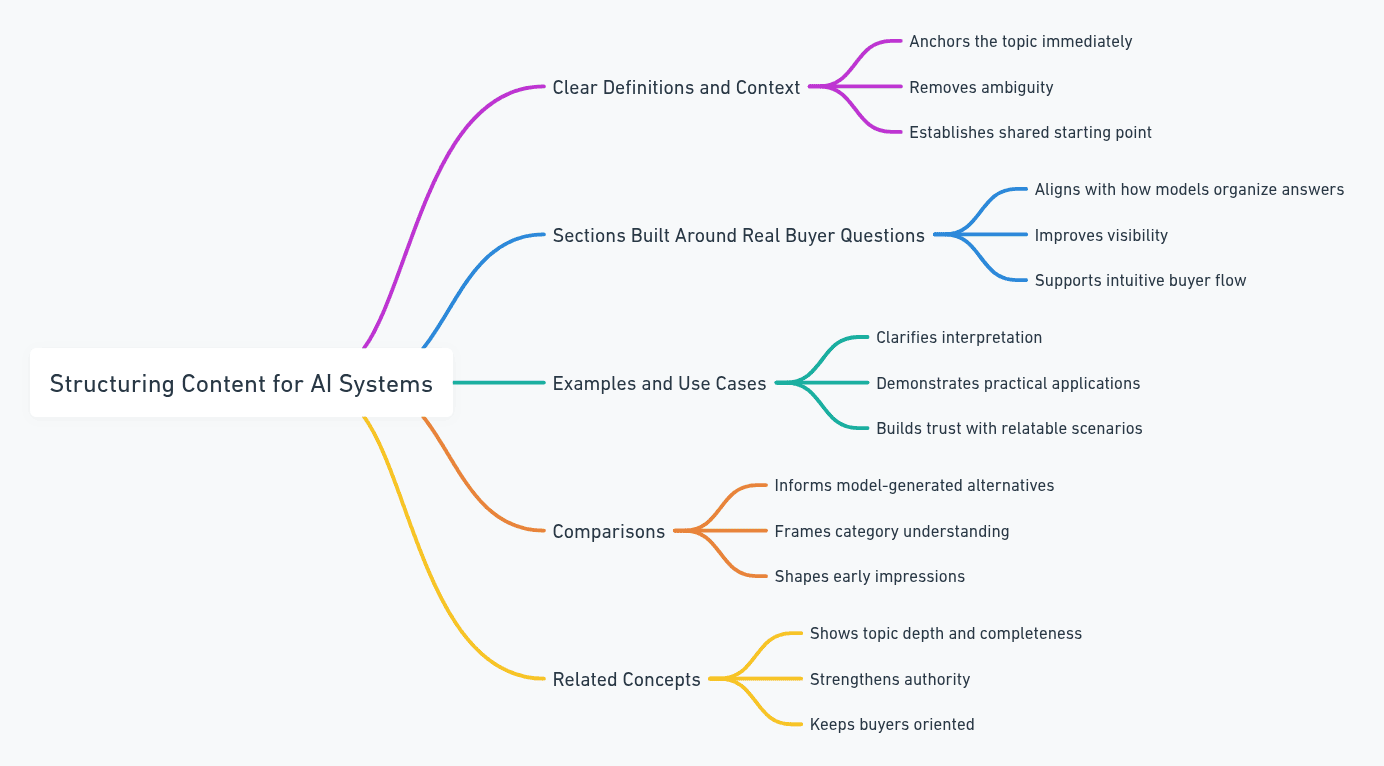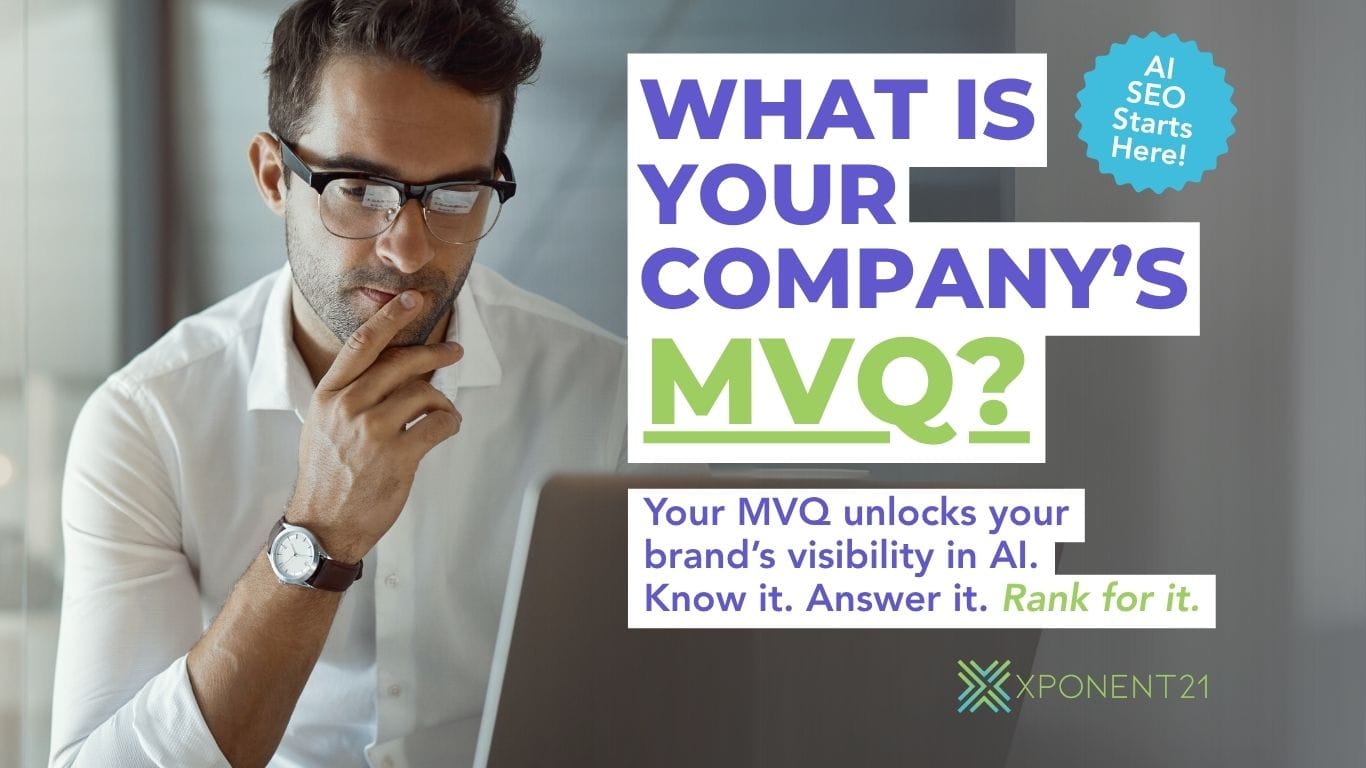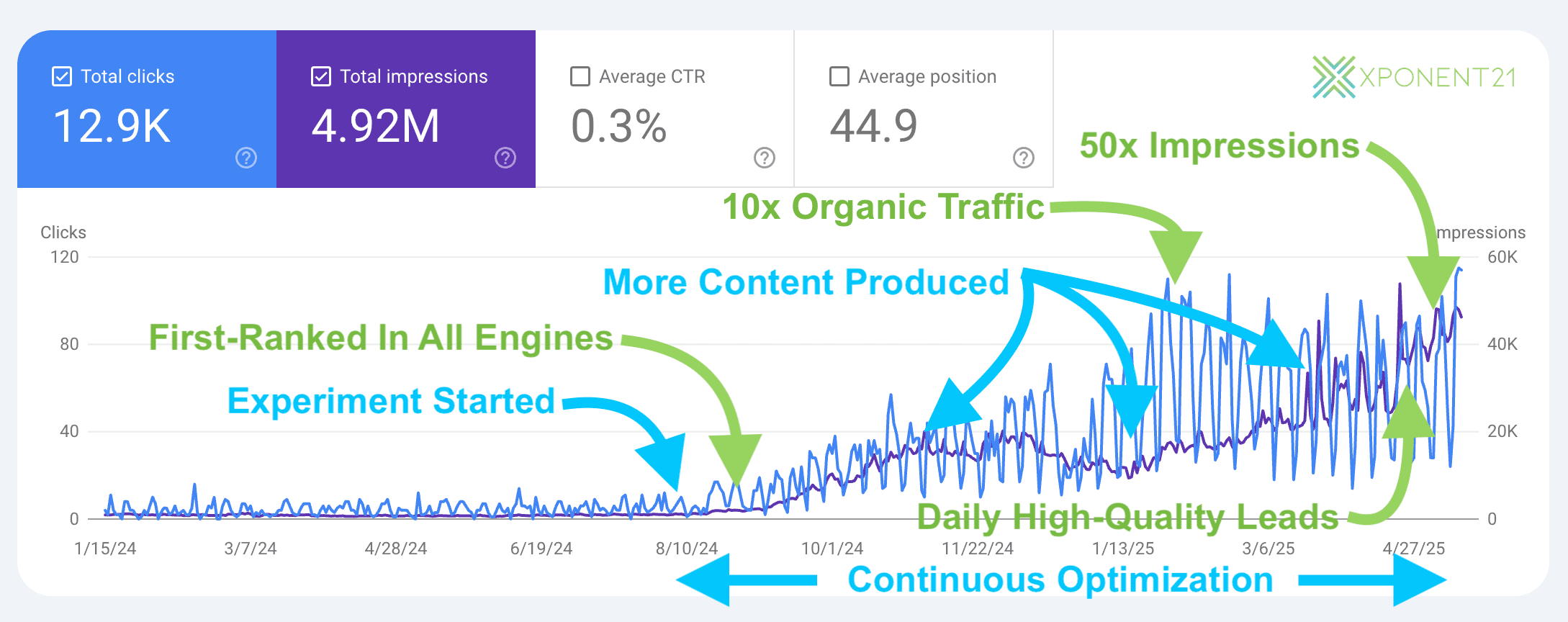
We’re a B2B company too — and for years, organic traffic didn’t move the needle for us. That changed when we shifted our SEO strategy to align with how AI systems evaluate, summarize, and recommend content. Today, we generate organic leads every day, and our website traffic has grown more than 4,000%.
This didn’t happen because we chased trends or played algorithm hopscotch. It happened because we rebuilt our content around structure, clarity, and the actual questions buyers and AI systems ask.
B2B buyers now rely heavily on AI assistants to make sense of complex decisions. They want concise explanations, strategic context, and authoritative guidance. When your content reflects that, AI systems can interpret your expertise and surface your brand at the exact moment intent forms.
AI SEO isn’t a prediction — it’s a practical method that improves visibility in both traditional search and AI-generated answers. And it works.
See our flagship guide, How to Optimize Your Website and Content to Rank in AI Search Results.
Contents
- Why AI Matters in B2B Search
- How AI Has Changed Discovery
- Building Strong AI SEO Foundations
- Search Intent for B2B in an AI World
- Structuring Content for AI Systems
- Scaling Content for Modern B2B Needs
- Strengthening B2B Visibility With AI-Driven Optimization
- Practical Steps for B2B Teams
- The Role Xponent21 Plays
Why AI Matters in B2B Search
B2B buyers aren’t browsing endlessly. They’re gathering clarity, validating assumptions, and checking whether a solution aligns with their workflow. AI systems approach information similarly: they scan, compare, and look for clear expertise.
When your content gives AI a coherent understanding of your capabilities, your visibility expands across summaries, comparisons, and traditional results.
How AI Has Changed Discovery
Three shifts now influence how B2B brands get found, and each one changes how your content needs to perform:
1. Buyer questions now start broader and earlier in the process.
Instead of beginning with product-specific searches, buyers begin with strategic questions that help them understand the landscape. They’re looking for context — definitions, frameworks, comparisons, and decision factors — before they ever start evaluating individual vendors. If your content only speaks to bottom-of-funnel intent, you’re missing where modern research begins.
2. AI assistants shape early impressions long before someone reaches your website.
These systems condense the field, provide summaries, and frame the categories buyers operate within. If you aren’t present in those explanations, you feel irrelevant before a visitor ever sees your brand. This doesn’t replace website traffic, but it heavily influences who buyers consider worth investigating.
3. Content completeness carries more weight than isolated keywords.
AI systems gravitate toward pages that answer the primary question and the surrounding questions that naturally come with it. When your content connects ideas, clarifies terminology, and shows how concepts relate to each other, it becomes much easier for models to surface and reference.
Together, these shifts favor companies whose content genuinely helps buyers think, plan, and evaluate — not just companies that target traditional keyword volumes.
B2B brands that moved early saw outsized gains—read our analysis in First-Mover Advantage in AI SEO.
Building Strong AI SEO Foundations
The companies making real progress with AI SEO aren’t relying on tricks or narrow optimizations. They’re building content ecosystems that help both buyers and AI systems understand their expertise clearly. A few patterns show up consistently:
Clear topical focus
Pages that perform well tend to stay anchored to one core idea. When a page has a defined purpose — and avoids drifting into unrelated angles — AI systems can categorize it cleanly. This clarity also helps buyers move through information without confusion, which strengthens confidence.
Depth and completeness
Surface-level content creates uncertainty. When a topic is explained from end to end — covering definitions, decision factors, comparisons, and practical considerations — AI systems gain a more accurate understanding of your authority. Depth also reduces the need for buyers to look elsewhere to fill in gaps.
Connected ideas
Strong pages don’t exist in isolation. They reference related concepts, explain how pieces fit together, and acknowledge the questions buyers naturally ask along the way. These connections help AI systems understand the role your content plays within the larger topic and surface it more reliably.
Consistent structure
When your content follows a recognizable format across the site — clear intros, logical sections, terminology used the same way — models interpret it more confidently. A stable structure signals that your perspective is dependable, which increases visibility across both traditional search and AI-driven answers.
Search Intent for B2B in an AI World
B2B search intent typically revolves around:
- how a solution works
- where it fits
- what alternatives exist
- how ROI is justified
- what integrations require
- how to prepare for deployment
Content that reflects these layers — in one coherent flow — performs best.
Structuring Content for AI Systems

Content resonates when it includes:
1. Clear definitions and context
This anchors the topic immediately. It also removes ambiguity for both the reader and the model, giving them a shared starting point. When the basics are established up front, everything that follows is easier to interpret and easier to surface in summarized answers.
2. Sections built around real buyer questions
This supports how models organize answers. AI systems pull from content that mirrors the question-and-response patterns buyers already use, so structuring your sections this way improves visibility. It also helps readers move through information in a way that feels intuitive to their decision-making process.
3. Examples and use cases
This clarifies interpretation. Concrete scenarios help AI understand the practical application of your solution, making it more likely to reference your content accurately. They also help buyers see themselves in the situation, which strengthens engagement and trust.
4. Comparisons
This informs how models present alternatives. When you frame the differences between approaches, methods, or tools, AI often adopts that framing in its summaries. It gives you influence over how the category is explained, which can shape early impressions.
5. Related concepts
This reinforces your authority. Connecting a topic to its surrounding ideas shows depth and completeness, two signals AI relies on when determining which sources to surface. It also helps buyers stay oriented as they explore the broader landscape.
Scaling Content for Modern B2B Needs
Today’s content demands exceed what traditional workflows can support. Research, clustering, structure, drafting, improvements, and standards need to work together.
At Xponent21, we build these systems using a combination of AI models, automated checks, and content engineering workflows — including platforms like AirOps — to maintain consistency and clarity at scale.
It’s part of how we help clients move faster without sacrificing depth or structure. Understanding how to use AI tools properly is covered in detail in The Truth About AI Content and SEO.
Strengthening B2B Visibility With AI-Driven Optimization
AI SEO helps B2B companies:
- appear inside AI-generated summaries
- align content with buyer expectations
- build topic authority
- increase qualified inbound traffic
- improve visibility during evaluation stages
These gains compound as your ecosystem becomes more complete. We’ve documented exponential outcomes from applying this approach in What It’s Like When Your Business Ranks at the Top of AI Search Results.
Practical Steps for B2B Teams
Start with the basics:

1. Identify topics tied to revenue.
These influence qualification and sales cycles, and they usually map directly to the Most Valuable Questions (MVQs) your buyers are asking. Prioritizing these topics ensures your content aligns with real demand and supports the parts of the journey that matter most.
2. Give each page a singular purpose.
One job, executed clearly. When a page stays tightly focused on its core intent, both buyers and AI systems can interpret it without confusion. This clarity strengthens how the page performs and how it gets referenced.
3. Cover adjacent questions.
This supports better visibility. When your content anticipates and addresses the natural follow-up questions that surround a topic, it becomes more complete and more valuable to both users and AI models.
4. Standardize terminology.
Models rely on consistency. Using the same words to describe the same concepts throughout your site reduces ambiguity, reinforces your perspective, and helps AI systems build a coherent understanding of your expertise.
5. Update legacy content.
Bring older material up to today’s expectations. Refreshing structure, terminology, and completeness helps older pages re-enter visibility and strengthens your broader content ecosystem.
The Role Xponent21 Plays
AI SEO isn’t a one-off project. It’s a system — one built on structure, clarity, and the ability to generate consistent, high-quality content that aligns with how AI models interpret expertise.

Our work with clients focuses on creating those systems:
- clarity of the existing content ecosystem
- organized content frameworks
- structured pages that answer real buyer questions
- workflows that accelerate production
- standards that keep everything consistent
- ongoing improvements as models evolve
If your B2B brand needs a scalable, modern approach to organic growth, this is the work we do every day.
Further Reading to Elevate Your AI SEO Strategy
You’ve absorbed the core tactics — now let’s go further. The three articles below build on this strategy, helping you position your brand for higher visibility, stronger authority, and greater conversion in the AI-driven search world.
- AI SEO Guide: How to Build an Unrivaled Content Library That Wins at AI Search — A detailed guide on building a content library that earns citations, visibility and trust in AI-driven search scenarios.
- AI SEO Strategies: A Practical Guide for Marketing Leaders — A practical, approachable resource showing how marketing leadership can adapt content strategies to be both human-friendly and AI-friendly.
- How to Use B2B Video in Marketing to Drive Conversions — A focused take on how video content enhances B2B conversion outcomes in the context of evolving discovery and content consumption behavior.
- Google AI Overviews Clear 60% as New Data Suggests ChatGPT Will Surpass Google Search Traffic by 2027 - November 16, 2025
- AI SEO for B2B Companies: How to Compete in an AI-Driven Search Landscape - November 16, 2025
- AI Search Visibility: Quantifying the Brand Exposure Advantage - November 2, 2025
Affiliate Disclosure
A link to AirOps appears in this article. It is an affiliate link, which means Xponent21 may earn a commission if you sign up using it — at no additional cost to you. We include it because it’s one of the tools that supports our content engineering work, and transparency matters.
